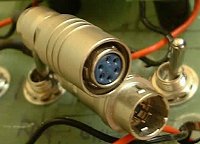ONBOARD VIDEO
ONBOARD VIDEO CAMERA
CAMERA / TRACKING TIPS
1. Don't be seduced by the cheap miniature cameras with built in transmitters. The frequency control on the transmitters tends to drift, which makes it hard to keep a lock on the signal, especially in the case of onboard a rocket, the range on them is generally dreadful (do remember, they are not designed for use in rockets working at long ranges), they often suffer from microphonic effects due to the vibration and acceleration effects of the rocket, and the quality of the picture is generally very poor.
2. High resolution Bulletcams, whilst being more expensive, are generally much better quality than the cheaper boardcams and the combined camera / transmitter systems. There are some boardcams which use the same good quality CCD imaging chips, and which are similarly priced to bulletcams, which are good quality however, but generally, where size is at a premium, such as in rocket applications, the high resolution Bulletcams are the better option.
3. If you insist on buying a combined camera / transmitter, check the frequency of any camera / transmitter combination you plan on buying. Some of the cheaper offers on online sites such as eBay, do not operate in the legal, licence-free ISM band at 2.4 GHz, but at other frequencies such as 1.2 and 1.3 GHz. In the UK, you cannot use transmitters at 1.2 GHz or 1.3 GHz for this application unless you have a Test and Development Licence, and these are site specific, person specific and furthermore, they are not cheap.
4. The legal maximum power output for any transmitter used in this application is 10 miliwatts. An example of a legal transmitter is the 10 miliWatt, 2.4 GHz transmitter sold by Maplin (order code: DV68Y). A transmitter such as this, has a far greater range than the combined camera / transmitter systems.
5. The Receiver Antenna is very important! A good receiver antenna can help offset the shortcomings of a bad transmitter and bad receiver. It will never completely make up for the other components of the system if they are really lousy, but it will certainly help. A helical antenna is generally more useful than a Yagi-Uda antenna for an application such as a rocket, where the orientation of the rocket changes, and thus the polarization of the transmitter beam varies. If you can afford one, a helical antenna such as those sold by Sandpiper Aerials is a good quality helical antenna.
6. Try and use low loss cable between the Receiver Antenna and the Receiver, and try and ensure that connectors with correctly matched impedances are used. In rocketry applications, the received signal is often very weak, so every opportunity to reduce signal loss, and improve gain should be taken, since this will result in a better (clearer) signal being received.
Typical connectors are SMA connectors on the transmitters, and SMA connectors or N-type connectors on the receivers and receiver antennae (for RF (Radio Frequency) connections in the 2.4 GHz waveband). The N-type connectors are more rugged and robust, and often it is possible to use a small length of cable with an SMA connector at one end, and an N-type connector at the other end (referred to as a pigtail), as an adaptor from receivers with an SMA connector. That way, it is possible to have a receiver antenna connected to a receiver via a cable with N-type connectors at each end, which makes for a more robust connection.
7. Basically, to summarise; you get what you pay for. Cheap will generally mean low quality. The more you spend (either component by component), or all at once, the better the quality of the video that is received.
CONSTRUCTION TIPS
1. Plan the system carefully. Draw out all connections first, label in what connectors are to be used, what type of wiring, and what the pinout arrangement on connectors will be.
2. Do not try and save money on cheap connectors. It really is a false economy. The advantage of decent connectors is robustness and reliability. There is a reason the professional space industry use decent quality connectors - you do not want connectors failing on multi million pound launchers.

3. Pay special attention to the build quality of anything you construct. By far the major cause of system failures with video systems onboard rockets is poor quality construction. The most common areas of bad construction include:
- Bad soldering - dry joints, or poorly soldered links to connectors. There is nothing worse than turning up to a launch, powering one's system up, and then discovering intermittent problems, usually attributable to poor soldering.
- Use of insulation tape rather than heat shrink on connectors. This is a common mistake. Insulation tape lacks the "grip" that heat shrink provides, and consequently, increases the chance of any wires working themselves loose with lack of adequate strain relief.
4. Test the entire system before the day of the launch. Turning up to a launch with an untried, untested video system, is a recipe for disaster.
DISCLAIMER
Note - It is against the law to transmit video signals at certain wavelengths in the U.K without the appropriate licence and permission. This web page does not in any way condone activities of this nature without such a licence.
See Also
Hybrid Rocket Science, Hybrid Rocket Help Clinic, Amateur Hybrid Motors, Amateur Liquid Rockets, Guidance, Gimballed Motors, Launch Controller, UK Rocketry Vendors, UK Rocket Groups, UK Space Organisations

